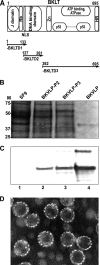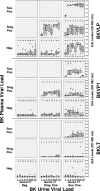Antibody responses to recombinant polyomavirus BK large T and VP1 proteins in young kidney transplant patients
- PMID: 19474265
- PMCID: PMC2725654
- DOI: 10.1128/JCM.00030-09
Antibody responses to recombinant polyomavirus BK large T and VP1 proteins in young kidney transplant patients
Abstract
BK virus (BKV)-specific immunity is critical for polyomavirus-associated nephropathy, but antibody responses are incompletely defined. We compared the hemagglutination inhibition assay (HIA) with immunoglobulin G enzyme immunoassays (EIA) to BKV proteins expressed in baculovirus-infected insect cells. N-terminal, internal, and C-terminal domains of the BKV large T antigen (BKLT) were fused to glutathione S-transferase (GST), yielding GST-BKLTD1, GST-BKLTD2, and GST-BKLTD3, respectively. The BKV capsid VP1 was expressed as a GST fusion (BKVP1) or as a native VP1 assembled into viruslike particles (BKVLP). We tested 422 sera from 28 healthy donors (HD), 99 dialysis patients (DP; median age, 15 years; range, 3 to 32 years), and 46 age-matched kidney transplant patients (KTP; median age, 15 years; range, 2 to 33 years). In HD, HIA and BKVLP EIA both yielded a 91.7% seroreactivity, whereas all other EIA responses were lower (BKVP1, 83.3%; BKLTD1, 25%; BKLTD2, 29%; BKLTD3, 40%). HIA titers significantly correlated with EIA levels for BKVLP, BKVP1, and BKLTD1 but not for BKLTD2 or BKLTD3, which were barely above the cutoff. In DP, the seroreactivities of HIA, BKVLP, and BKLTD1 were lower than that in HD (63.6%, 86.9%, and 10.1%, respectively) and they had lower titers (P < 0.001). In KTP, seropositivities for BKVLP, BKVP1, and BKLTD1 were 78%, 50%, and 17%, respectively, but anti-BKVLP levels increased significantly in KTP with viruria and viremia, whereas anti-BKLTD1 levels increased after clearing sustained BKV viremia. In conclusion, anti-BKVLP is equivalent to HIA in HD but is more sensitive to determine the BKV serostatus in DP and KTP. In KTP, anti-BKVLP responds to recent BKV viruria and viremia, whereas anti-BKLTD1 may indicate emerging BKV-specific immune control.
Figures




Similar articles
-
Human polyomavirus type 1 (BK virus) agnoprotein is abundantly expressed but immunologically ignored.Clin Vaccine Immunol. 2007 Aug;14(8):959-68. doi: 10.1128/CVI.00123-07. Epub 2007 May 30. Clin Vaccine Immunol. 2007. PMID: 17538118 Free PMC article.
-
Interplay of cellular and humoral immune responses against BK virus in kidney transplant recipients with polyomavirus nephropathy.J Virol. 2006 Apr;80(7):3495-505. doi: 10.1128/JVI.80.7.3495-3505.2006. J Virol. 2006. PMID: 16537617 Free PMC article.
-
Correlation of BK Virus Neutralizing Serostatus With the Incidence of BK Viremia in Kidney Transplant Recipients.Transplantation. 2017 Jun;101(6):1495-1505. doi: 10.1097/TP.0000000000001261. Transplantation. 2017. PMID: 27854236
-
BK virus-associated viruria and viremia in a patient with lymphangioleiomyomatosis after lung re-transplantation: A case report and review of the literature on BK virus infection post-lung transplantation.J Infect Chemother. 2019 Oct;25(10):820-824. doi: 10.1016/j.jiac.2019.04.002. Epub 2019 Apr 23. J Infect Chemother. 2019. PMID: 31027885 Review.
-
Polyomavirus-associated nephropathy: update on BK virus-specific immunity.Transpl Infect Dis. 2006 Jun;8(2):86-94. doi: 10.1111/j.1399-3062.2006.00167.x. Transpl Infect Dis. 2006. PMID: 16734631 Review.
Cited by
-
Neutralization serotyping of BK polyomavirus infection in kidney transplant recipients.PLoS Pathog. 2012;8(4):e1002650. doi: 10.1371/journal.ppat.1002650. Epub 2012 Apr 12. PLoS Pathog. 2012. PMID: 22511874 Free PMC article. Clinical Trial.
-
Recent Updates on Viral Oncogenesis: Available Preventive and Therapeutic Entities.Mol Pharm. 2023 Aug 7;20(8):3698-3740. doi: 10.1021/acs.molpharmaceut.2c01080. Epub 2023 Jul 24. Mol Pharm. 2023. PMID: 37486263 Free PMC article. Review.
-
Commercially available immunoglobulins contain virus neutralizing antibodies against all major genotypes of polyomavirus BK.Am J Transplant. 2015 Apr;15(4):1014-20. doi: 10.1111/ajt.13083. Epub 2015 Mar 3. Am J Transplant. 2015. PMID: 25736704 Free PMC article.
-
Comparing effects of BK virus agnoprotein and herpes simplex-1 ICP47 on MHC-I and MHC-II expression.Clin Dev Immunol. 2013;2013:626823. doi: 10.1155/2013/626823. Epub 2013 Mar 27. Clin Dev Immunol. 2013. PMID: 23606871 Free PMC article.
-
JC polyomavirus replication and associated disease in pediatric renal transplantation: an international CERTAIN Registry study.Pediatr Nephrol. 2018 Dec;33(12):2343-2352. doi: 10.1007/s00467-018-4029-9. Epub 2018 Jul 30. Pediatr Nephrol. 2018. PMID: 30058047
References
-
- Acott, P. D. 2006. Polyoma virus in pediatric renal transplantation. Pediatr. Transplant. 10856-860. - PubMed
-
- Andrews, C., K. V. Shah, R. Rubin, and M. Hirsch. 1982. BK papovavirus infections in renal transplant recipients: contribution of donor kidneys. J. Infect. Dis. 145276. - PubMed
-
- Andrews, C. A., K. V. Shah, R. W. Daniel, M. S. Hirsch, and R. H. Rubin. 1988. A serological investigation of BK virus and JC virus infections in recipients of renal allografts. J. Infect. Dis. 158176-181. - PubMed
-
- Bernhoff, E., T. J. Gutteberg, K. Sandvik, H. H. Hirsch, and C. H. Rinaldo. 2008. Cidofovir inhibits polyomavirus BK replication in human renal tubular cells downstream of viral early gene expression. Am. J. Transplant. 81413-1422. - PubMed
-
- Binet, I., V. Nickeleit, H. H. Hirsch, O. Prince, P. Dalquen, F. Gudat, M. J. Mihatsch, and G. Thiel. 1999. Polyomavirus disease under new immunosuppressive drugs: a cause of renal graft dysfunction and graft loss. Transplantation 67918-922. - PubMed
Publication types
MeSH terms
Substances
LinkOut - more resources
Full Text Sources
Research Materials

